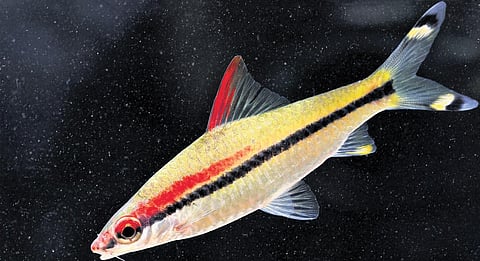

ROURKELA: Despite having limited available water resources, the tribal-dominated Sundargarh district with the help of modern fishing techniques, has achieved increased fish production in recent years.
Though the district still procures around 3,700 tonnes of fish annually from different states for consumption, with the gradual rise in production by fish farmers, it has produced around 20,800 tonnes of fish in 2022-23. The district targets to achieve self-sufficiency in the next five years.
Sundargarh district fisheries officer Arun Kumar Sahoo said there has been a gradual rise in fish production as the district increased its capacity to 20,800 tonnes annually from around 14,000 tonnes five years back. He said the Fisheries and Animal Husbandry Department has been encouraging villagers to initiate fish farming using modern techniques.
“To promote pisciculture in open water bodies from this year, a women's self-help group (WSHG) of Kuanrmunda block has been entrusted to practice cage culture at the Mandira dam of the Rourkela Steel Plant (RSP) in Rajgangpur block. Besides, fresh work orders have been given to 28 WSHGs and 19 individuals to set up bio floc fish farming units,” he informed.
Sources said not very long ago, the inland fisheries of the district were limited and most of the economically weaker sections of people resorted to fishing in a scattered manner for consumption by the family and to earn a few bucks locally if there was a surplus catch. However, after the department engaged farmers to adopt pisciculture, the freshwater production scenario began improving with every passing year in the land-locked district.
Since the water holding capacity of the rivers remains low for most part of the year including near dry condition during summers, fish production is being carried out in farm ponds, biofloc units, shallow waters of the rivers and irrigation dams.
As of now, fish production in 4,500 private tanks, 2,284 gram panchayat tanks, 10 revenue ponds and individual fishing in rivers is underway. Meanwhile, nine primary cooperative fishermen societies are engaged in five irrigation dams. A total of 448 WSHGs are also involved in fish farming. Besides, 84 biofloc fish farming units are also operating.
The government fish farm in Sadar block is able to supply 54 lakh spawns and 30 lakh fry for seasonal breeding while that in Bisra block has an annual capacity to generate nine lakh fry. Meanwhile, the government fish farm in Bonai is under renovation. Earlier, spawns and fry were procured from West Bengal for breeding. With hardly 2,600 individual fishermen the vast district has to go a long way to boost its fish production capacity.